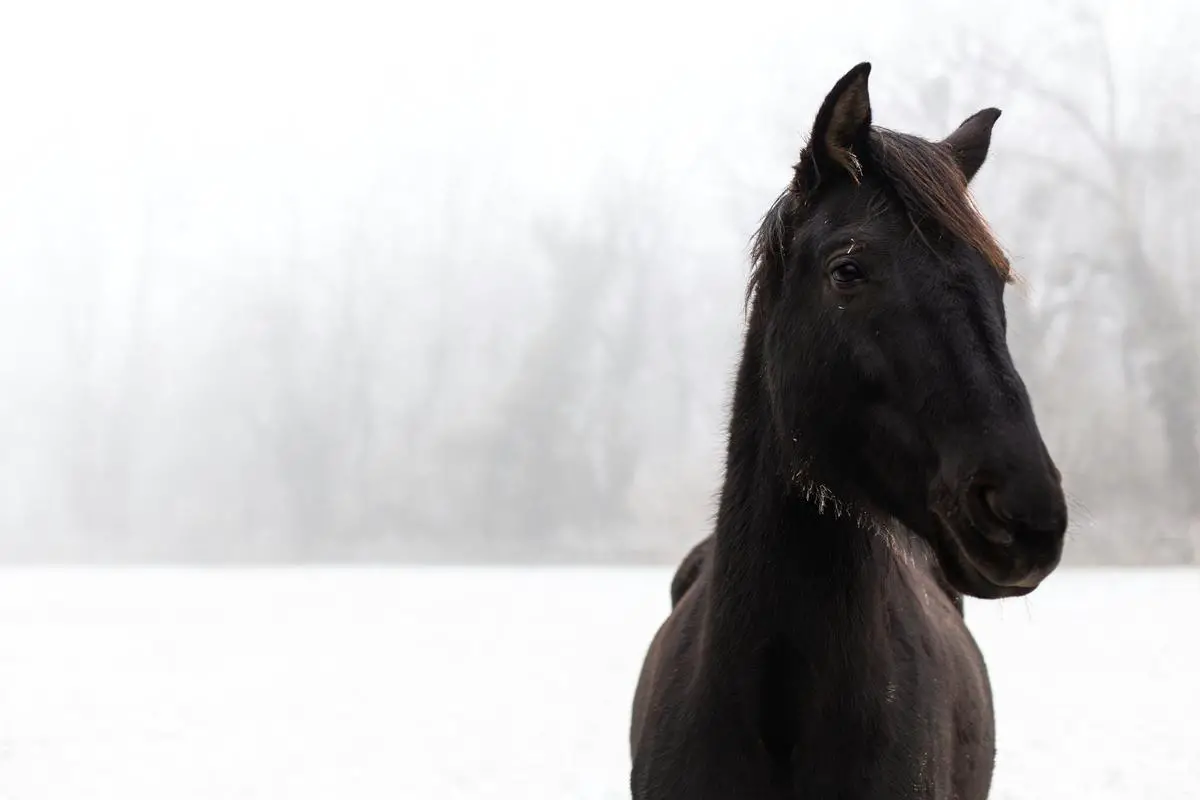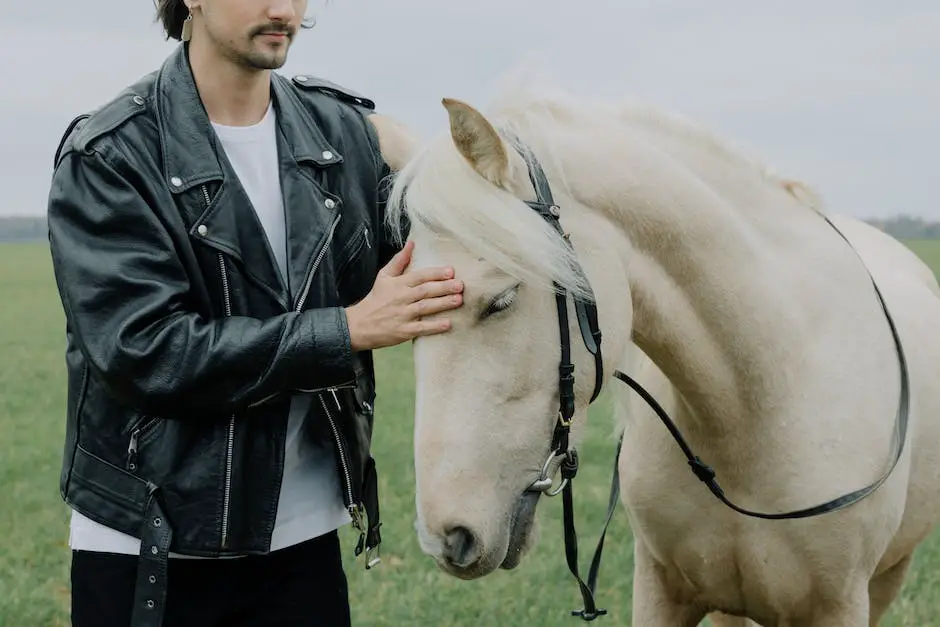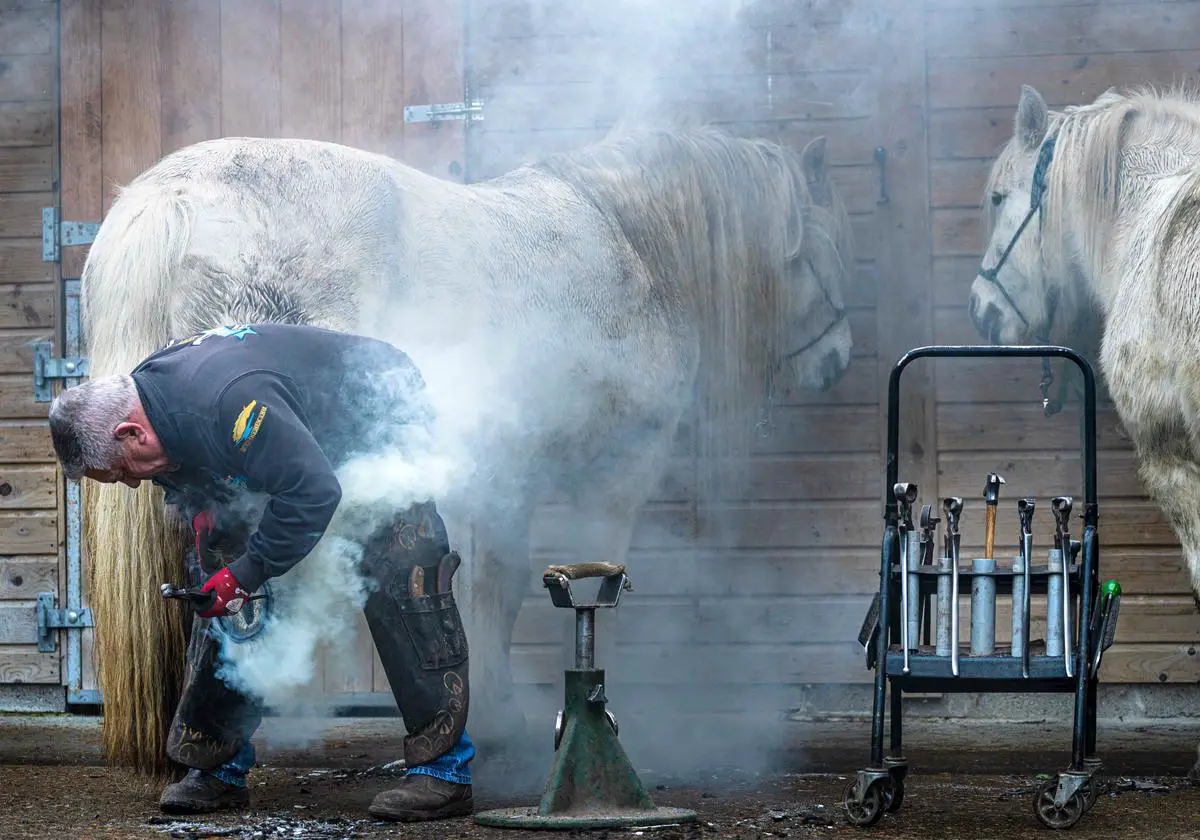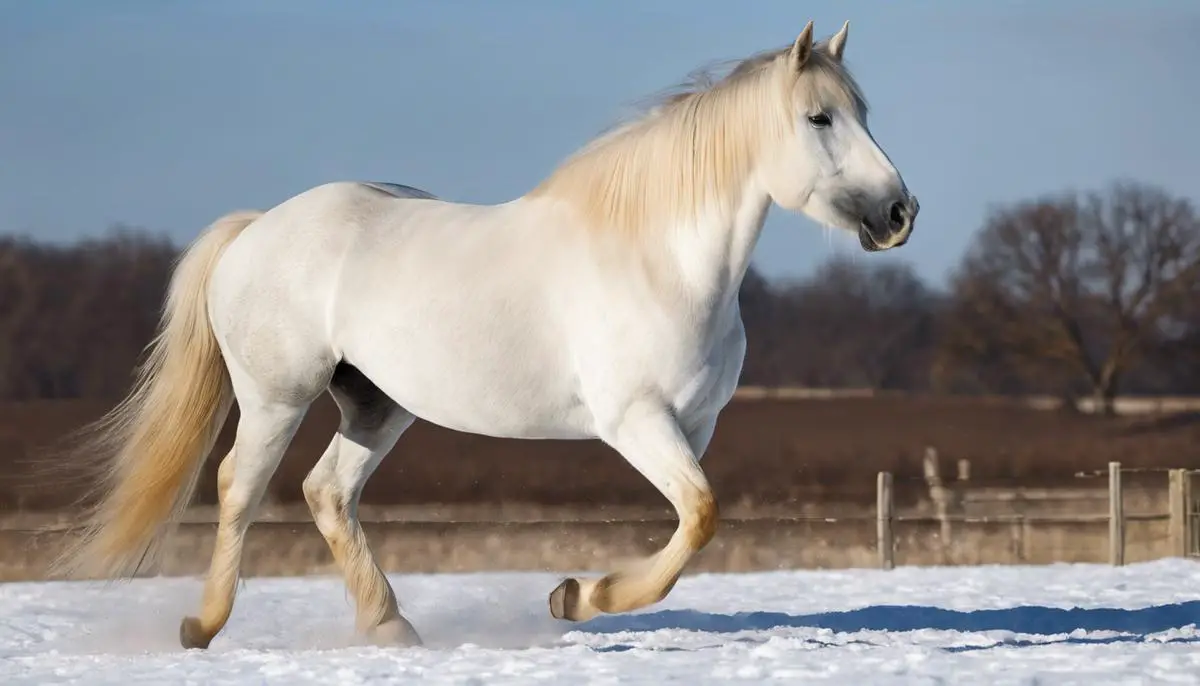Welcome to the world of cold-blooded horses, a realm where the steady heartbeats of these gentle giants echo a calm strength and unwavering reliability. As equestrian enthusiasts or curious hobbyists, diving into the classification of horse breeds can be as fascinating as it is enlightening. In the journey ahead, we’ll explore the distinct characteristics that set cold-blooded horses apart, painting a clear portrait of their placid temperament, robust physique, and how they differ from their hot-blooded and warm-blooded kin. Understanding these creatures down to their core is not just about appreciating their heavy build or serene disposition; it’s about recognizing the companions they can become when matched with the right human partner.
Table of Contents (Horspedia)
Understanding Cold-Blooded Horses
Diving into the World of ‘Cold-Blooded’ Horses
When you first dip your toes into the pool of horse breeds and types, the terms “cold-blooded,” “warm-blooded,” and “hot-blooded” might cause a bit of confusion. No, we’re not talking about their body temperature, but rather their breed characteristics and temperaments. Let’s unravel the mystery of cold-blooded horses and why they’re such beloved animals among equestrians!
So, what’s the deal with cold-blooded horses? “Cold-blooded” is a label that’s been affectionately given to draft horse breeds. These are the gentle giants of the horse world, including well-known breeds like the Clydesdale, Percheron, and Belgian. Standing tall, strong, and sturdy, these horses were originally bred for heavy farm and industrial work, pulling plows, wagons and carrying armored knights back in the olden days.
One of the most heartwarming qualities of cold-blooded horses is their calm and steady nature. This temperament makes them fantastic companions. Unlike their hot-blooded counterparts, who are high-spirited and speedy, cold-blooded horses are known for their patience and easygoing attitude. They’re like the considerate friend who’s always there to lend an ear – or in this case, a ride, no matter how novice the rider may be.
Another winning attribute of cold-blooded horses is their impressive strength. These horses pack a lot of power! They’re workhorses in the truest sense, able to perform demanding tasks with endurance that is simply mind-blowing. Their muscular build and solid hooves give them the ability to navigate through tough terrains and carry heavy loads without breaking a sweat.
One might think that such sizable creatures would have a voracious appetite to match, but surprisingly, cold-blooded horses are relatively easy keepers when it comes to their diet. They don’t require as much concentrated feeds as some other breeds, often maintaining their health and weight on good-quality forage.
Living with and caring for a cold-blooded horse can be an immensely fulfilling experience. Given their kind disposition and desire to please, these horses make not only excellent work companions but also great partners for leisure riding and even therapeutic activities. They truly embody the saying “gentle giant,” and getting to know one is like discovering a treasure chest of equine excellence.
Engaging with cold-blooded horses can teach us a lot about strength, patience, and the value of a calm, collected approach to challenges. Whether you’re pulling a harrow in a field or enjoying a peaceful trail ride, a cold-blooded horse by your side makes the journey that much more enjoyable.
So there you have it – a small window into the world of cold-blooded horses, where might meets mild, and where the line between a work companion and a cherished friend blurs into one rewarding package. Get to know them, and you might just find yourself a fan for life.

The Right Environment for Cold-Blooded Horses
Ensuring our cold-blooded horse buddies thrive means creating a haven that caters to their unique needs. Remember, these sturdy creatures are a world apart from their hot-blooded counterparts, so their living conditions should reflect that distinction.
First thing’s first: shelter. These horses need a cozy, draft-free stable. Ventilation is key to prevent respiratory problems – a balance between fresh air and warmth is ideal. Bedding should be generous, using straw or shavings to provide insulation against chilly ground. It’s like giving them a comfy sweater and warm bed all in one.
Now, let’s talk climate control. When temperatures dip, some might think, “Hey, throw on a blanket,” but it’s not always that simple. Cold-blooded horses have thick coats that are top-notch insulators. Overblanketing can cause overheating and sweating, which is trouble in the cold. If you do choose a blanket for particularly nippy days, opt for one that’s breathable and waterproof. It’s like choosing the right jacket for a snow day – not too bulky, but just right to stay warm and dry.
Exercise is another must. These horses are built for work, so keeping them fit is non-negotiable. Regular exercise helps maintain muscle tone and keeps the chill at bay. Plan for consistent workout schedules, even in winter, but be careful of icy or slippery conditions. Think of it as their gym membership for the year-round fitness goals.
Proper grooming is more than just about looks; it’s also about health and comfort. A well-groomed coat repels water and insulates better. So grab that curry comb and put some elbow grease into fluffing up that natural coat. It’s like how wearing a well-maintained, fluffy down jacket is warmer than one that’s matted and filthy.
Hydration is a big deal. Water buckets can freeze over, so ensuring a constant supply of drinkable, non-icy water is vital. Heated buckets or water heaters can be a lifesaver here. It’s much like making sure you have a hot cup of coffee on those brisk mornings.
Finally, companionship. Cold-blooded horses are often social animals, and loneliness can equal stress. A buddy in the stall next door or shared turnout time can make the difference. It’s the equine equivalent of hanging out with friends around a cozy fireplace.
So there you have it – the cozy, comfortable, and social home sweet home every cold-blooded horse deserves. Keep them warm, keep them moving, and keep them happy. With these tips in mind, your four-legged friend will be ready to weather any storm.

Photo by annemarieschaepman on Unsplash
Adoption Process and Considerations
When considering the adoption of a cold-blooded horse, it’s essential to dive into specific care details that ensure the well-being of these gentle giants. Here’s what enthusiasts should zero in on:
First up, let’s talk about the living quarters. The stable needs to be more than just a big box with hay; it’s got to be roomy with good airflow. However, don’t let drafts turn it into a wind tunnel. Insulation is key, but keep it breathable because nobody likes a stuffy room, not even a horse.
Blankets? Sure, they can be cozy, but these horses are like natural fuzzy bears. Slapping on too many layers or a too-heavy blanket can lead to sweaty discomfort. Think of it this way: it’s better to add layers if needed than to have to peel off a sweaty blanket.
Movement is the next big chapter. A cold-blooded horse is like a strong, silent type – they can be still as statues, but that can lead to stiff muscles. Regular walks, trots, or whatever you can manage keep their muscles as flexible as a yogi’s. It’s a win-win because exercise is also a great bonding time.
Grooming is another hotspot. Trust this; a well-brushed horse is a happy horse. Their coat is their winter jacket and raincoat combined. Regular grooming not only makes them shine like a new penny but also ensures their natural insulation stays top-notch.
Water – it’s a simple but a big deal. When it freezes, it’s useless to a horse, and licking an icicle is no way for a majestic beast to hydrate. So, whether you opt for heated buckets or water heaters, make sure that water is available 24/7.
Lastly, don’t forget the power of pals. Horses are social creatures, and cold-blooded horses enjoy a good neighbor. Whether it’s another horse, goat, or even a barn cat, companionship is the spice of their life.
There you have it! Focus on these care tips, and adopting a cold-blooded horse will turn from a daunting task into an avenue full of rewarding experiences.

Training and Bonding with Your Cold-Blooded Horse
Moving on to the juicy bits about training methods for these gentle giants – cold-blooded horses are known for their calm demeanor, which makes them exceptional partners when they receive the right kind of training. Here’s how to keep training effective and enjoyable for both the horse and the handler.
Start with Groundwork:
Foundation is key. Before hopping into the saddle, ensure that your horse knows the basics of groundwork. Use lunging, lead training, and liberty work to establish respect and communication. This isn’t about breaking spirits; it’s about building a trusting relationship. Remember to keep sessions short, sweet, and consistent.
Patience is Paramount:
Due to their laid-back nature, some might take a little longer to pick up on new commands or tricks. That’s totally okay. Give them the time they need and offer plenty of positive reinforcement. Rewards go a long way, whether it’s a verbal “good boy,” a pat, or the occasional treat.
Consistency is Crucial:
Like any good routine, consistency in training acts as the adhesive that makes everything stick. Whether it’s daily handling, riding, or command reinforcement, make it a habit. This equine breed thrives on a steady schedule.
Variety to Spice Up Training:
Even the mellowest of horses can get bored. Mix things up in training sessions. You could throw in some trail riding, light driving, or obstacle courses. These variations not only keep the horse engaged but also work different muscle groups and help with overall conditioning.
Understanding Their Capacity:
Because of their size, it’s important not to rush physical activities. Start with lighter exercises and gradually increase the intensity. This allows the horse to build strength and stamina without straining joints. Be especially mindful when training on hard surfaces, as this can be tough on their legs.
Tack That Fits:
Nothing hinders a good training session like ill-fitting gear. Make sure saddles, bridles, and harnesses fit comfortably. Take the time to adjust tack as needed, especially as your horse grows and develops muscle.
Voice Commands:
Cold-blooded horses respond well to voice cues, so use them consistently in training. A calm, confident tone works best. Vocalization adds another layer of communication and can be particularly useful in steering or stopping when working in harness or under saddle.
Awareness of Limitations:
Every horse, regardless of breed, has its own limits and comfort zones. Pay attention to these limits and work within them. Training should be about progress, not pushing boundaries to the point of stress or injury.
Lastly, training should always end on a good note. If your horse has worked hard and performed well, wrap up the session positively. Regardless of any setbacks during training, finding a moment of success to conclude with will leave your horse feeling good about the session – and looking forward to the next one. Keep these points in mind, and you’ll find that training your cold-blooded horse can not only be effective but a true joy.

Long-Term Care and Health Management
Coming to grips with hoof care and farrier visits for your cold-blooded steed is no small feat. Think of their hooves like the tires on a car—without the proper care and maintenance, you’re not going to get very far, and the ride won’t be comfortable.
Time to dig into the nitty-gritty. A well-rounded hoof care plan is essential. Make sure they’re getting regular trimmings every six to eight weeks to prevent overgrowth and other hoof issues. If you’re horsing around in areas with rocky terrain, consider shoes to protect those massive hooves. Not sure about shoes? No worries—ask your farrier what’s best for your horse’s hoof health and work requirements.
Now, parasites might as well be public enemy number one. Deworming is a big deal and should be on your radar. Work with a vet to develop a deworming schedule that matches the horse’s environment and lifestyle. This helps ensure those unwanted guests don’t overstay their welcome.
Believe it—teeth matter, too! Equine dental care comes with the territory. You can’t skimp on regular dental check-ups. Sharp edges on teeth can cause discomfort and interfere with eating and bit placement. A vet should check out your horse’s chompers once a year to keep everything in check.
Remember, cold-blood horses also pack on the pounds easily, so it’s crucial to manage their weight. Overfeeding can slip into obesity territory, which strains their heart and joints. Balance is key—enough to support their size and workload, but not so much they become couch potatoes.
Lastly, don’t forget those check-ups. Just like us, these gentle giants need their health monitored. Yearly vet visits are a must to catch any health concerns early and keep them in tip-top shape.
In a nutshell, it’s all about regular maintenance and staying in tune with your horse’s needs. Keep these tips in hoof, and you’ll be on the right track to preserving the health and happiness of your cold-blooded horse.

Photo by martinbennie on Unsplash
The path to mastering the care of a cold-blooded horse is imbued with lessons of patience, empathy, and a deep appreciation for the nuances that make these breeds so special. By engaging thoughtfully with every aspect of their lives—from creating the ideal habitat to nurturing a deep bond—we embark on a rewarding partnership. Embracing the unique qualities of these horses not only enhances their well-being but also enriches our own experience. The journey is as magnificent as the horse itself, and each step taken is a stride toward a harmonious equestrian life filled with mutual respect and shared moments of serenity. May these majestic creatures inspire you to a deeper understanding and a heart as steadfast as their own.

